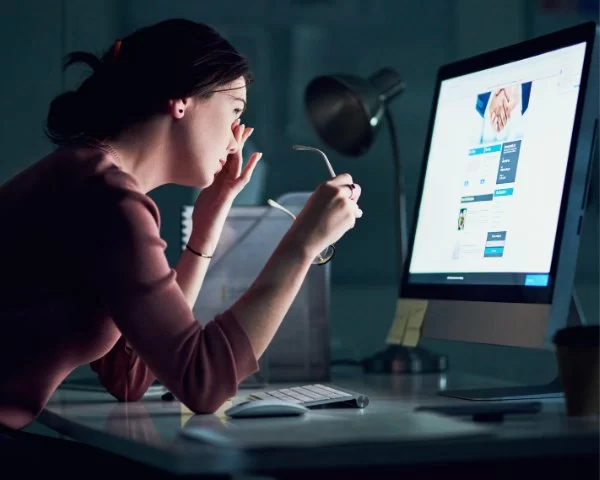
- understanding-eye-strain-in-graphic-designers - Understanding Eye Strain in Graphic Designers
- screen-environment-and-lighting-matters - Screen Environment and Lighting Matters
- practical-habits-to-reduce-eye-strain - Practical Habits to Reduce Eye Strain
- real-case-how-ryan-fixed-his-design-fatigue - Real Case: How Ryan Fixed His Design Fatigue
- tools-and-products-that-can-help - Tools and Products That Can Help
- when-to-seek-professional-eye-care - When to Seek Professional Eye Care
1. Understanding Eye Strain in Graphic Designers
For many creatives, design work is a passion. But when hours of intense screen time turn into burning eyes, blurred vision, and fatigue, that passion can be draining—literally. Knowing how to prevent eye strain in graphic designers is not just about being more productive—it’s about protecting long-term vision health and sustaining creative energy.
Eye strain, also called digital eye strain or computer vision syndrome, occurs when the eyes get tired from intense use. For graphic designers, this happens due to high-contrast visuals, extended periods of color correction, and prolonged focus on fine details. Fortunately, with the right strategies, it’s entirely preventable.
2. Screen Environment and Lighting Matters
2.1. Adjust Your Display Settings
One of the simplest ways to reduce eye fatigue is to tweak your screen settings. Increase contrast without over-brightening, reduce blue light exposure, and maintain a brightness level that matches your room’s ambient light. Many designers use software like f.lux or built-in “night shift” settings to soften harsh digital glare.
2.2. Mind Your Distance and Angle
The optimal distance between your eyes and the screen should be about 20 to 28 inches, with the screen’s center just below eye level. This positioning keeps your neck relaxed and eyes focused without strain. Investing in a monitor arm can help achieve this setup easily.
2.3. Control Room Lighting
Overhead lighting or glare from windows can increase strain. Soft, diffused light that doesn’t reflect on your screen is ideal. Some professionals even use bias lighting—LED strips placed behind the monitor—to reduce contrast between the screen and the surrounding space.
3. Practical Habits to Reduce Eye Strain
3.1. The 20-20-20 Rule
Every 20 minutes, look at something 20 feet away for 20 seconds. It’s a small habit, but it resets your focus and gives your eyes the rest they need throughout the day. Setting a timer or using reminder apps can make this effortless.
3.2. Blink—Yes, Really
When you're deeply focused, blinking becomes less frequent, leading to dry eyes. Keep artificial tears handy and make a conscious effort to blink during long sessions. This is especially important when using large screens or dual monitor setups.
3.3. Schedule Screen-Free Breaks
Design marathons are part of the creative process, but stepping away from the screen is non-negotiable. A 5–10-minute break every hour—standing up, stretching, or even walking outside—can refresh both mind and eyes.
4. Real Case: How Ryan Fixed His Design Fatigue
Ryan, a UX designer from Portland, found himself struggling with headaches and blurred vision after long design sprints. He thought it was just “part of the job”—until he visited Eye Docs.
“I was shocked to learn I was developing early signs of eye strain-induced dryness,” Ryan said. His optometrist suggested screen filters, corrected ergonomic posture, and blue light glasses. Within two weeks, the headaches disappeared, and Ryan even said his creativity felt sharper. “My focus improved, and I didn’t dread long sessions anymore.”
Ryan’s case is a reminder: pain is not a price you have to pay for productivity.
5. Tools and Products That Can Help
5.1. Anti-Glare Screen Protectors
These reduce reflection and eye fatigue significantly. Some also come with blue light filtering capabilities, adding an extra layer of comfort for extended design work.
5.2. Ergonomic Desk Accessories
Monitor risers, adjustable chairs, and keyboard trays all contribute to better posture and a more eye-friendly workspace. Aligning your visual field can reduce the amount of strain your eye muscles endure throughout the day.
5.3. Blue Light Glasses
Blue light blocking glasses are now available in a wide range of stylish and prescription-ready options. They don’t just protect your eyes—they can improve sleep quality and reduce late-night screen impact. For reliable recommendations, Eye Docs offers professionally vetted options tailored for digital creatives.
6. When to Seek Professional Eye Care
6.1. Watch for Warning Signs
Persistent dryness, blurry vision, headaches, or difficulty focusing aren’t just annoyances—they’re warning signs. If these symptoms persist even after trying home adjustments, consult an eye care professional promptly.
6.2. Annual Eye Exams for Designers
Graphic designers should consider yearly eye exams a non-negotiable health practice. These exams can detect strain-related changes early and provide custom advice on how to adjust your visual habits or prescription. At Eye Docs, specialists understand the unique challenges digital artists face and offer care that aligns with your work style.








